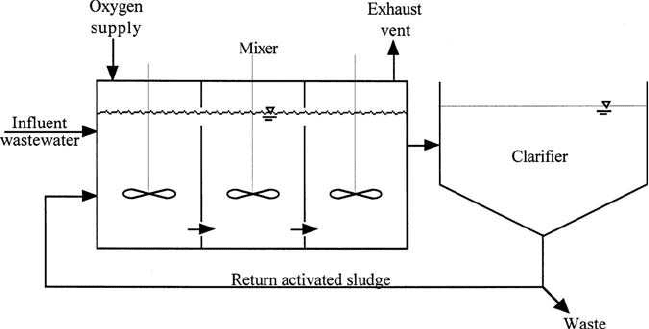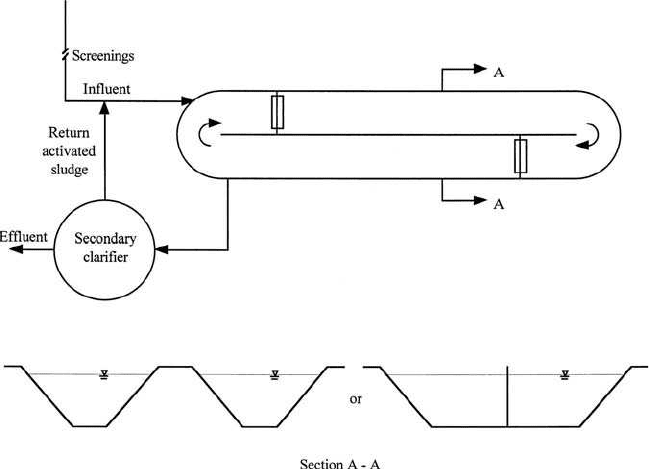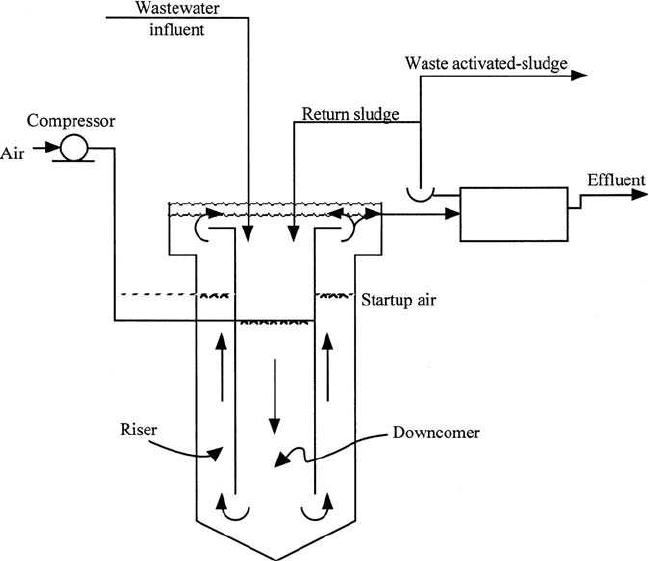Lin S.D. Water and Wastewater Calculations Manual
Подождите немного. Документ загружается.


Wastewater Engineering 675
The process has been developed in an attempt to match oxygen supply
and oxygen demand and to use a high-rate process through mainte-
nance of high concentrations of biomass. The major components of the
process are an oxygen generator, using high-purity oxygen in lieu of
air, a specially compartmented aeration basin, a clarifier, pumps for
recirculating activated sludge, and sludge disposal facilities. Oxygen is
generated by manufacturing liquid oxygen cryogenically on-site for large
plants and by pressure swing adsorption for small plants. Standard
cryogenic air separation involves liquefaction of air followed by fractional
distillation to separate the major components of oxygen and nitrogen.
The aeration basin is divided into compartments by baffles and is
covered with a gastight cover. An agitator is included in each compart-
ment (Fig. 6.24). High-purity oxygen is fed concurrently with waste-
water flow. Influent wastewater, return activated sludge, and oxygen gas
under slight pressure are introduced to the first compartment. A dis-
solved oxygen concentration of 4 to 10 mg/L is normally maintained in
the mixed liquor. Successive aeration compartments are connected to
each other through submerged ports. Exhausted waste gas is a mixture
of nitrogen, carbon dioxide, and approximately 10% of oxygen supplied
and vented from the last stage of the system. Effluent mixed liquor is
then settled in a secondary clarifier. Settled activated sludge is recir-
culated to the aeration basin, with some wasted. The process is used for
general application with high-strength wastes with limited space.
Design parameters of high-purity oxygen systems are: BOD
5
loading ⫽
1.6 to 3.2 kg/(m
3
⭈ d) (100 to 200 lb/(1000 ft
3
⭈ d)), MLSS ⫽ 3000 to 8000
mg/L, F/M ⫽ 0.25 to 1.0 per day, HRT ⫽ 1 to 3 days, u
c
⫽ 8 to 20 days,
and Q
r
/Q ⫽ 0.25 to 0.5. The BOD
5
removal efficiency for the process is
85% to 95% (WEF and ASCE, 1992).
Figure 6.24 Schematic flow diagram of a high-purity activated-sludge system.

676 Chapter 6
Advantages of the high-purity oxygen activated-sludge process include
higher oxygen transfer gradient and rates, smaller reaction chambers,
improved biokinetics, the ability to treat high-strength soluble waste-
water, greater tolerance for peak organic loadings, reduced energy
requirements, reduction in bulking problems, a better settling sludge
(1% to 2% solids), and effective odor control.
In a comparison of air and pure oxygen systems, researchers reported
little or no significant difference in carbonaceous BOD
5
removal kinet-
ics with DO concentration about 1 to 2 mg/L. Lower pH values (6.0 to 6.5)
occur with high-purity oxygen and loss of alkalinity, with nitrate pro-
duction. Covered aeration tanks have a potential explosion possibility.
Example: The high-purity oxygen activated-sludge process is selected for
treating a high-strength industrial wastewater due to limited space.
Determine the volume of the aeration tank and check with design parame-
ters, using the following data.
solution:
Step 1. Determine the tank volume
Using Eq. (6.88)
F/M ⫽ 0.7/day
where X ⫽ 5500 mg/L ⫻ 0.8 ⫽ 4400 mg/L
8.34 ⫽ conversion factor, lb/(Mgal ⭈ (mg/L))
Therefore V 5
1 Mgal/d 3 280 mg/L 3 8.34
s0.7/dayd 3 4400 mg/L 3 8.34
V 5
QS
0
sF/Md X
F/M 5
S
0
uX
5
QS
0
VX
Design average flow 1 Mgal/d (3785 m
3
/d)
Influent BOD 280 mg/L
Influent TSS 250 mg/L
F/M 0.70 lb BOD applied/(lb MLVSS ⭈ d)
MLSS 5500 mg/L
VSS/TSS 0.8
Maximum volumetric BOD loading 200 lb/(1000 ft
3
⭈ d)
⫽ 3.2 kg/(m
3
⭈ d)
Minimum aeration time 2 h
Minimum mean cell residence time 3 days

Wastewater Engineering 677
⫽ 0.0909 Mgal
⫽ 344 m
3
⫽ 12,150 ft
3
Step 2. Check the BOD loading
⫽ 192 lb/(1000 ft
3
⭈ d)
⬍ 200 lb/(1000 ft
3
⭈ d) (OK)
⫽ 3.08 kg/(m
3
⭈ d)
Step 3. Check the aeration time
⫽ 0.0909 day ⫻ 24 h/d
⫽ 2.2 h
⬎ 2.0 h (OK)
Step 4. Check mean cell residence time (sludge age)
Influent VSS X
i
⫽ 0.8 ⫻ 250 mg/L
⫽ 200 mg/L
⫽ 2.0 days
⬍ 3.0 days (OK)
Oxidation ditch.
The oxidation ditch process was developed by Pasveer
(1960) in Holland and is a modification of the conventional activated-
sludge plug-flow process. The system is especially applicable to small
communities needing low-cost treatment. The oxidation ditch is typically
an extended aeration mode. It consists typically of a single or closed-loop
elongated oval channel with a liquid depth of 1.2 to 1.8 m (4 to 6 ft) and
45-degree sloping sidewalls (Fig. 6.25).
Wastewater is given preliminary treatment such as screening, com-
minution, or grit removal (usually without primary treatment). The
wastewater is introduced into the ditch and is aerated using mechanical
aerator(s) (Kessener brush) which are mounted across the channel for
an extended period of time with long HRT of 8 to 36 h (typically 24 h)
and SRT (solids residence time) of 20 to 30 days (WEF and ASCE, 1992).
u
c
5
VX
QX
i
5
0.0909 Mgal 3 4400 mg/L
1 Mgal/d 3 200 mg/L
HRT 5
V
Q
5
0.0909 day 3 24 h/d
1
BOD loading 5
1.0 Mgal/d 3 280 mg/L 3 8.34 lb/sMgal
#
smg/Ldd
12.15 3 1000 ft
3

678 Chapter 6
The aerators provide mixing and circulation in the ditch, and oxygen
transfer. The mechanical brush operates in the 60 to 110 rev/min range
and keeps the liquid in motion at velocities from 0.24 to 0.37 m/s (0.8 to
1.2 ft/s), sufficient to prevent deposition of solids. A large fraction of the
required oxygen is supplied by transfer through the free surface of the
wastewater rather than by aeration. As the wastewater passes the aer-
ator, the DO concentration rises and then falls while the wastewater
traverses the circuit.
The BOD
5
loading in the oxidation ditch is usually as low as 0.08 to
0.48 kg/(m
3
⭈ d) (5 to 30 lb/(1000 ft
3
⭈ d)). The F/M ratios are 0.05 to 0.30
per day. The MLSS are in the range of 1500 to 5000 mg/L. The activated
sludge in the oxidation ditch removes the organic matter and converts
it to cell protoplasm. This biomass will be degraded for long solids res-
idence time.
Separate or interchannel clarifiers are used for separating and return-
ing MLSS to the ditch. Recommendations for unit size and power
requirements are available from equipment manufacturers.
The oxidation ditch is popular because of its high BOD
5
removal effi-
ciency (85% to 95%) and easy operation. Nitrification occurs also in the
system. The oxidation ditch is a flexible process and is used for small
communities where large land area is available. However, the surface
Figure 6.25 Schematic diagram of oxidation ditch activated-sludge process.

Wastewater Engineering 679
aerators may become iced during the winter months. Electrical heating
must be installed at the critical area. During cold weather the opera-
tion must prevent loss of efficiency, mechanical damage, and danger to
the operators.
Example 6: Estimate the effluent BOD
5
to be expected of an oxidation ditch
treating a municipal wastewater with an influent BOD of 220 mg/L. Use the
following typical kinetic coefficients: k ⫽ 5/d; K
s
⫽ 60 mg/L of BOD; Y ⫽ 0.6 mg
VSS/mg BOD; k
d
⫽ 0.06/d; and u
c
⫽ 20 d.
solution:
Step 1. Estimate effluent substrate (soluble BOD
5
) concentration
From Eq. (6.80)
⫽ 2.3 mg/L
Step 2. Estimate TSS in the effluent
Using Eq. (6.78)
⫽ 59.4 mg/L
Step 3. Estimate the effluent BOD
It is commonly used that 0.63 mg BOD will be exerted (used) for each mg of
TSS. Then, the effluent total BOD is
BOD ⫽ 2.3 mg/L ⫹ 0.63 ⫻ 59.4 mg/L
⫽ 39.7 mg/L
Deep shaft reactor.
A new variation of the activated-sludge process,
developed in England, the deep shaft reactor is used where costs of land
are high. It is used for general application with high-strength wastes.
There are a number of installations in Japan. It has been marketed in
the United States and Canada.
The deep shaft reactor consists of a vertical shaft about 120 to 150 m
(400 to 500 ft) deep, utilizing a U-tube aeration system (Fig. 6.26). The
5
20 days 3 0.6s220 2 2.3d mg/L
20 dayss1 1 0.06/day 3 20 daysd
X 5
u
c
YsS
0
2 Sd
us1 1 k
d
u
c
d
5
60 mg/Ls1 1 20 days 3 0.06/dayd
20 dayss0.6 3 5/days 2 0.06/dayd 2 1
S 5
K
s
s1 1 u
c
k
d
d
u
c
sYk 2 k
d
d 2 1

680 Chapter 6
shaft replaces the primary clarifiers and aeration tanks. The deep
shaft is lined with a steel shell and fitted with a concentric pipe to form
an annular reactor. Wastewater, return activated sludge, and air is
forced down the center of the shaft and allowed to rise upward through
the annulus (riser). The higher pressures obtained in the deep shaft
improve the oxygen transfer rate and more oxygen can be dissolved,
with beneficial effects on substrate utilization. DO concentration can
range from 25 to 60 mg/L (Droste, 1997). Microbial reaction rates are
not affected by the high pressures. Temperature in the system is fairly
constant throughout the year. The flow in the shaft is a plug-flow
mode. The F/M ratios are 0.5 to 5.0 per day and the HRT ranges from
0.5 to 5 h.
A flotation tank serves for the separation of the biomass (solids) from
the supernatant. Most of the solids are recirculated to the deep shaft
reactor, and some are wasted to an aerobic digester. The effluent of the
reactor is supersaturated with air when exposed to atmospheric pres-
sure. The release of dissolved air from the mixed liquor forms bubbles
that float suspended solids to the surface of the flotation tank.
Figure 6.26 Schematic diagram of deep shaft activated-sludge system.
Wastewater Engineering 681
The advantages of the deep shaft reactor include lower construction
and operational costs, less land requirement, capability to handle big
organic loads, and suitability for all climatic conditions.
Biological nitrification. Conversion of ammonia to nitrite and nitrate can
be achieved by biological nitrification. Biological nitrification is performed
either in single-stage activated-sludge carbon oxidation and ammonia
reduction or in separate continuous-flow stir-tank reactors or plug-flow.
The single-stage nitrification process is used for general application
for nitrogen control where inhibitory industrial wastes are not present.
The process also removes 85% to 95% of BOD.
The design criteria for single-stage activated-sludge nitrification are:
volumetric BOD loading ⫽ 0.08 to 0.32 kg/(m
3
⭈ d) (5 to 20 lb/(1000
ft
3
⭈ d)); MLSS ⫽ 1500 to 3500 mg/L; u ⫽ 6 to 15 h; u
c
⫽ 8 to 12 days;
F/M ⫽ 0.10 to 0.25 per day; and Q
r
/Q ⫽ 0.50 to 1.50 (Metcalf and Eddy,
Inc. 1991; WEF and ASCE, 1991a).
The advantage of the separate-stage suspended-growth nitrification
system is its flexibility to be optimized to conform to the nitrification
needs. The separate-stage process is used to update existing systems
where nitrogen standards are stringent or where inhibitory industrial
wastes are present and can not be removed in the previous stages.
The design criteria for the separate-stage nitrification process are: vol-
umetric BOD loading ⫽ 0.05 to 0.14 kg/(m
3
⭈ d) (3 to 9 lb/1000 (ft
3
⭈ d)),
very low; F/M ⫽ 0.05 to 0.2 per day; MLSS ⫽ 1500 to 3500 mg/L; HRT ⫽
3 to 6 h; u
c
⫽ 15 to 100 days (very long); and Q
r
/Q ⫽ 0.50 to 2.00. More
details on single-stage and separate-stage biological nitrification are
given under advanced treatment for nitrogen removal in a later section.
21.8 Aeration and mixing systems
The treatment efficiency of an activated-sludge process depends on the
oxygen dissolved in the aeration tank and the transfer of oxygen supply
from the air and from pure oxygen. Oxygen is transferred to the mixed
liquor in an aeration tank by dispersing compressed air bubbles through
submerged diffusers with compressors or by entraining air into the
mixed liquor by surface aerators. A combination of the above has also
been used. An air diffusion system consists of air filters and other
conditioning equipment, blowers, air piping, and diffusers, including dif-
fuser cleaning devices.
A large number of combinations of mixing/aeration equipment and
tank configuration have been developed.
Oxygen transfer and utilization. Oxygen transfer is a two-step process.
Gaseous oxygen is first dissolved in the mixed liquor by diffusion or
682 Chapter 6
mechanical aeration or both. The dissolved oxygen is utilized by the
microorganisms in the process of metabolism of the organic matter.
When the rate of oxygen utilization exceeds the rate of oxygen dissolu-
tion, the dissolved oxygen (DO) in the mixed liquor will be depleted. This
should be avoided. DO should be measured periodically, especially
during the period of peak loading, and the air supply then adjusted
accordingly.
The rate of oxygen transfer from air bubbles into solution is written
as (Hammer, 1986)
r ⫽ k(bC
s
– C
t
) (6.113)
where r ⫽ rate of oxygen transfer from air to liquid, mg/(L ⭈ h)
k ⫽ transfer coefficient, per h
b ⫽ oxygen saturation coefficient of the wastewater
⫽ 0.8 to 0.9
C
s
⫽ DO concentration at saturation of top water
(Table 1.2), mg/L
C
t
⫽ DO concentration in mixed liquor, mg/L
bC
s
– C
t
⫽ DO deficit, mg/L
The greater the DO deficit, the higher the rate of oxygen transfer. The
oxygen transfer coefficient k depends on wastewater characteristics
and, more importantly, on the physical features of the aeration, liquid
depth of the aeration tank, mixing turbulence, and tank configuration.
The rate of DO utilization is essentially a function of F/M ratio and
liquid temperature. The biological uptake of DO is approximately
30 mg/(L ⭈ h) for the conventional activated-sludge process, generally less
than 10 mg/(L ⭈ h) for extended aeration, and as high as 100 mg/(L ⭈ h)
for high-rate aeration. Aerobic biological reaction is independent of DO
above a minimum critical concentration. However, if DO is below the
critical value, the metabolism of microorganisms is limited by reduced
oxygen supply. Critical concentrations reported for various activated-
sludge systems range from 0.2 to 2.0 mg/L, the most commonly being
0.5 mg/L (Hummer, 1986). Ten States Standards stipulates that aera-
tion equipment shall be capable of maintaining a minimum of 2.0 mg/L
of DO in mixed liquor at all times and provide thorough mixing of the
mixed liquor (GLUMRB, 1996).
Oxygen requirements generally depend on maximum diurnal organic
loading (design peak hourly BOD
5
), degree of treatment, and MLSS. The
Ten States Standards (GLUMRS, 1996) further recommends that the
normal design air requirement for all activated-sludge processes except
extended aeration shall provide 1500 ft
3
/lb of BOD
5
loading (94 m
3
/kg
BOD
5
). For extended aeration the value shall be 2050 ft
3
/lb of BOD
5
(128 m
3
/kg of BOD
5
). The design oxygen requirement for all activated-
sludge processes shall be 1.1 lb oxygen/lb design peak hourly BOD
5
applied.
Wastewater Engineering 683
Example 1: Compare the rate of oxygen transfer when the existing DOs in
the mixed liquor are 3.0 and 0.5 mg/L. Assume the transfer coefficient is
2.8/h and oxygen saturation coefficient is 0.88 for wastewater at 15.5⬚C.
solution:
Step 1. Find C
s
at 15.5⬚C
From Table 1.2
C
s
⫽ 9.92 mg/L
Step 2. Calculate oxygen transfer rates, using Eq. (6.113)
At DO ⫽ 3.0 mg/L
r ⫽ k( bC
s
– C
t
)
⫽ (2.8/h) (0.88 ⫻ 9.92 ⫺ 3.0) mg/L
⫽ 16.0 mg/(L ⭈ h)
At DO ⫽ 0.5 mg/L
r ⫽ (2.8/h) (0.88 ⫻ 9.92 ⫺ 0.5) mg/L
⫽ 23.0 mg/(L ⭈ h)
Note: The higher the DO deficit, the greater the oxygen transfer rate.
Example 2: Determine the oxygen transfer efficiency of a diffused aeration
system providing 60 m
3
/kg BOD
5
applied (960 ft
3
/lb BOD
5
). Assume that the aer-
ation system is capable of transferring 1.1 kg of atmospheric oxygen to DO in
the mixed liquor per kg BOD
5
applied, and that 1 m
3
of air at standard conditions
(20⬚C, 760 mm Hg, and 36% relative humidity) contains 0.279 kg of oxygen.
solution:
Step 1. Calculate oxygen provided per kg BOD
5
Oxygen provided ⫽ 60 m
3
/kg BOD ⫻ 0.279 kg/m
3
⫽ 16.7 kg/kg BOD
Step 2. Determine oxygen transfer efficiency e
e ⫽ oxygen transferred/oxygen provided
⫽ (1.1 kg/kg BOD)/(16.7 kg/kg BOD)
⫽ 0.066
⫽ 6.6%
Diffused air aeration.
A diffused air aeration system consists of diffusers
submerged in the mixed liquor, header pipes, air mains, blowers (air
compressors), and appurtenances through which the air passes. Ceramic
diffusers (porous and nonporous) are manufactured as tubes, domes, or
plates. Other diffusers, such as jets or U-tubes, may be used. Compressed
684 Chapter 6
air forced through the diffusers is released as fine bubbles. The oxygen
is then introduced to the liquid.
The oxygen requirement for the aeration can be calculated using
Eq. (6.94) or (6.95). In practice, the efficiency of oxygen transfer of a
diffusion and sparging device seldom exceeds 8%. The oxygen trans-
fer efficiency for various bubble sizes is available from the manu-
facturer’s data. The diffuser system should be capable of providing
for 200% of the designed average daily oxygen demand (GLUMRB,
1996).
Air piping. As compressed air flows through a pipe, its volume changes
according to the pressure drop. The total headloss from the blower (or
silencer outlet) to the diffuser inlet shall not exceed 0.5 lb/in
2
(3.4 kPa)
under average operational conditions (GLUMRB, 1996). The pressure
drop in a pipeline carrying compressed air can be calculated by the
Darcy–Weisbach formula (Eq. (4.17)).
The value of friction factor f can be determined from the Moody dia-
gram. However, as an approximation, the friction factor of a steel pipe
carrying compressed air is expressed as (Steel and McGhee, 1979)
f ⫽ 0.029D
0.027
/Q
0.148
(SI units) (6.114)
f ⫽ 0.013D
0.027
/Q
0.148
(US customary units) (6.115)
where f ⫽ friction factor
D ⫽ diameter of pipe, m or ft
Q ⫽ flow of air, m
3
/min or gal/min
The headloss in a straight pipe is calculated from
H ⫽ f(L/D)h
r
(6.116)
where H ⫽ headloss in pipe, mm or in
L ⫽ length of pipe, m or ft
D ⫽ diameter of pipe, m or ft
h
r
⫽ velocity head, mm or in
Another approximation of the estimation of headloss in a pipe can be
expressed as
H ⫽ 9.82 ⫻ 10
–8
(fLTQ
2
)/(PD
5
) (6.117)
where T ⫽ temperature of air, K
P ⫽ absolute pressure, atm
Other terms are as given above.
